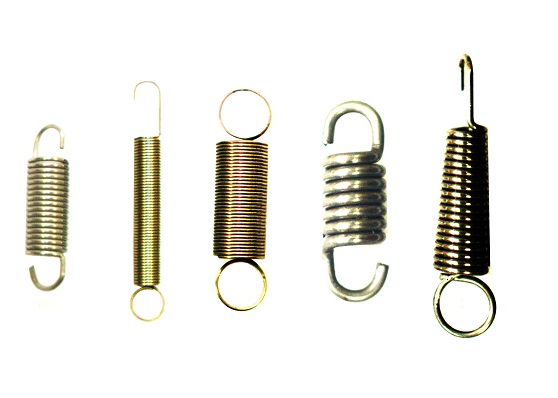Springs Materials and Application
The main performance requirements of spring steel are high strength and high yield limit and fatigue limit, so the spring steel uses a higher carbon content. However, the hardenability of carbon steel is poor, so alloy steel must be used for springs with larger cross-sections. The main alloying elements in alloy spring steel are silicon and manganese, which can enhance the hardenability and yield ratio of steel.
Springs Materials
The most widely used spring material is spring steel (SUP). Carbon steel is used for springs with smaller diameters, and the process is mostly cold-drawn forming, such as: 65#, 75#, 85#. The diameter is slightly larger, and the springs that need to be produced by the thermoforming process are mostly 60Si2Mn, such as automobile leaf springs and buffer springs for railway vehicles. For important springs with high stress, 50CrV can be used, which are commonly used in high-end car leaf springs and engine valve springs. Other spring steel materials include: 65Mn, 50CrMn, 30W4Cr2V, etc.
1. Carbon steel and alloy steel: When manufacturing springs, metal elements such as silicon, manganese, chromium, vanadium, and molybdenum are often added to the steel to increase the elasticity and fatigue limit of the spring and make it resistant to impact.
2. Large springs are mostly processed by hot work, that is, the spring material is rolled into a rod at high temperature, and then processed at high temperature, then quenched in oil or water at about 780°C to 850°C, and then tempered at a temperature of 400°C to 500°C.
3. Small springs, such as steel wire, piano wire or steel belt, are annealed first, then processed by cold work, and then hardened and tempered after being rolled.
4. The piano wire is made of high-carbon steel (0.65~0.95%), with less impurities. When the diameter is usually less than 1/4, it is drawn into a thread at room temperature after bremming treatment. It has good mechanical properties, high tensile strength and high bremsstrahlung. , It is an excellent coil spring material.
5. Stainless steel wire is used in places that are susceptible to corrosion. High-speed steel and stainless steel can be used to withstand high temperatures.
6. The carbon content of the oil tempered wire is 0.6-0.7% should contain manganese, and 0.6-1.0% is often used for coil springs.
7. Ordinary steel of 0.9 to 1.0% is commonly used for leaf springs, and chromium vanadium steel and silicon manganese steel are used for higher grades.
Springs often work under variable loads and impact loads, and are required to not produce plastic deformation under extreme stress. Therefore, spring materials are required to have high tensile strength limits, elastic limits and fatigue strength limits, and are not easy to relax. . At the same time, high impact toughness and good heat treatment performance are required. Common spring materials are high-quality carbon steel, alloy steel and copper alloy.
Springs Materials Choosing
When selecting materials, the use, importance, working conditions (such as load properties, size and cycle characteristics, working temperature and surrounding media, working time, etc.) of the spring, processing methods, heat treatment and economic efficiency should be considered. For example, carbon spring steel has low price, high strength, and good performance. It is widely used in small springs subject to static load and limited number of times of variable load; alloy steel has high strength, good elasticity, and high temperature resistance, and is suitable for larger and larger sizes. Springs that can withstand impact loads; stainless steel is corrosion-resistant and high-temperature resistant, and is suitable for springs working in corrosive media; copper alloys have good corrosion resistance and anti-magnetic properties, but low strength, suitable for small forces and require corrosion resistance And anti-magnetic spring. Table 3 shows the size series and tensile strength limit of high-quality carbon spring steel wire for reference during design.
The material of non-metal springs is mainly rubber, in addition to plastic, cork and air.
The allowable stress of the spring material is related to the type of material, the nature of the load, the heat treatment method, the size of the spring wire, the working condition and the importance of the spring. The allowable stress of the spring is divided into three categories according to the number of cycles of variable load (see Table 2 ); important springs with cycle times above 106 (such as internal combustion engine valve springs and electromagnetic brake shoe brake springs, etc.) are Class I; springs with cycle times between 103-106 and impact load (such as governor springs and general Vehicle springs, etc.) are Class II; springs with cycles below 103 (such as general safety valve springs and frictional safety clutch springs, etc.) are Class III.
Carbon spring steel has high strength, good performance, sufficient supply, and wide application. It is suitable for manufacturing springs with spring wire diameter d≤13mm. According to the purpose, it is divided into three grades: grade B (d=0.08-10mm) for low-stress springs; grade C d=0.08-10mm for medium-application springs; grade D (d=0.08-6.0mm) for high-stress springs .
Custom springs manufacturer
Follows are some details for our springs.







